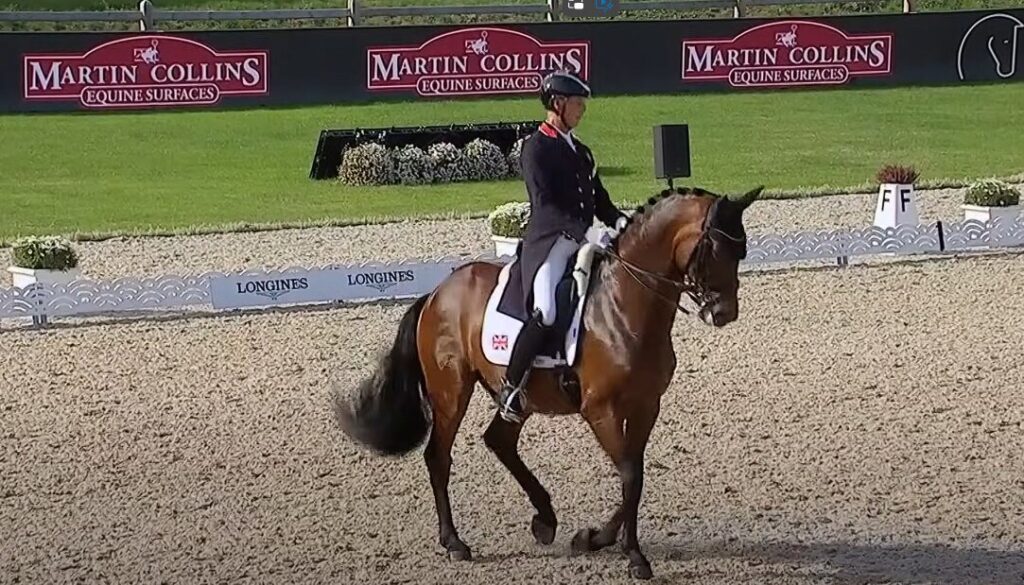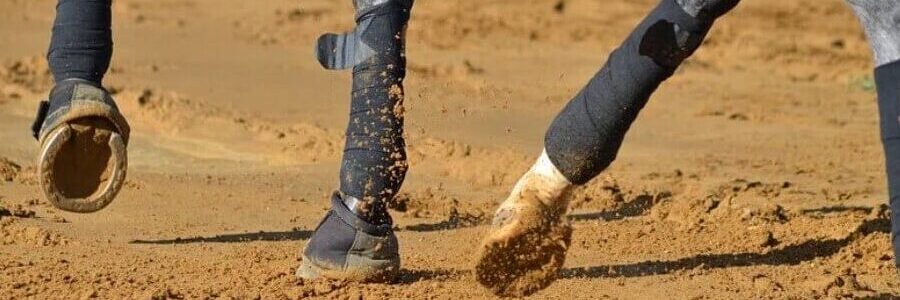
The Riding Arena
If you have ever taken riding lessons, you will likely have done so in a riding arena, also called a school or a manege. The French word manège comes from the Italian word maneggio meaning riding school, and should not be confused with another French word ménage, meaning household.
Arenas in some form have been used for riding and training horses for a long time. There is good evidence that a riding arena of sorts, called the Cavallerizza, was used in Naples in Italy from perhaps as early as the mid-fourteenth century. From Italy they spread to neighbouring countries, until by the nineteenth century they could be found throughout Europe.
Advantages of Riding in an Arena
There are many advantages of riding in an arena. Importantly for those taking lessons, it provides a controlled environment. The horse can only go as far the fence, and can’t, for example, take a novice rider for a gallop. The ground of the arena is relatively uniform and provides better footing for the horse. It also means a softer landing for the rider should they fall.
The defined working area means that the rider has to learn to control the horse within the boundaries of the arena. On the other hand, working in the arena requires the horse to have good balance and control, and so riding in the arena helps the horse to develop these skills.
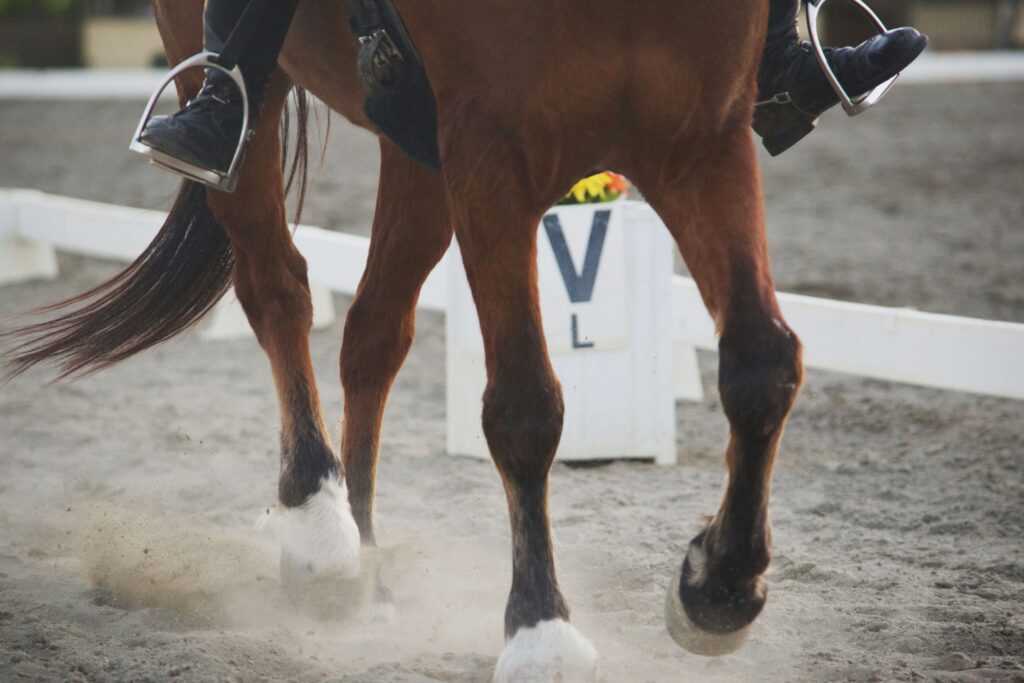
The horse can be ridden independently on the right or left rein to ensure balanced development. If the horse is weaker on a particular rein (as is often the case), then the weaker side can be strengthened and improved. Many arenas also install mirrors at particular points along the outside so the rider can view how they are positioned on the horse, or how they are executing a particular action.
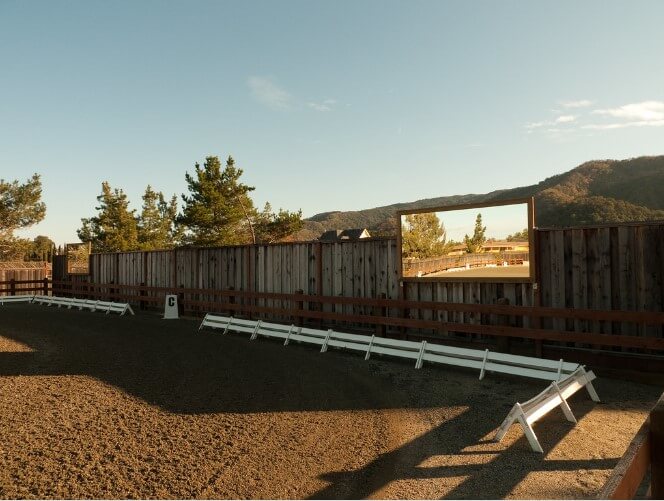
Finally, as competitions take place within common area sizes (see below), it means that competitors can learn and practise in the same layout wherever they are. The test of skills, such as those demonstrated in dressage, is done within a known and established area.
Sizes
While an arena can be of any size, there are two sizes that are used in dressage, and these are also popular sizes to be found in riding schools and private arenas. The smaller of the two sizes measures 40 metres by 20 (132 x 66 ft), and is a good layout for lessons and general practice. The larger size measures 60 metres by 20 (197 x 66 ft), and is the standard size used for most dressage competitions around the world.
There are other sizes of arena used in other disciplines. For example, jumping arenas often need to be larger, and a small jumping arena may be 60 metres by 30 (197 x 99 ft), while a larger one may be 80 metres by 50 (263 x 164 ft). A private arena can of course be any size that the owner wishes, and many riding schools have a few arenas of varying sizes in line with the space and resources that they have available.
Layout of the Dressage Arena
Dressage arenas have specific markers at particular points around the arena. These markers are made up of various letters of the alphabet that identify them. The markers are found in most riding schools, regardless of the size of the arena, and regardless of whether they are actually used for dressage.
The letters help the rider to navigate around the arena and to know their position. Particular movements can be done in relation to the markings, and it makes communication between an instructor and rider easier. For example, the instructor can request the rider move diagonally across the arena along a specific line by simply giving the instruction to ride between two particular letters. The instruction will be the same in any arena as the layout of the letters is always the same.
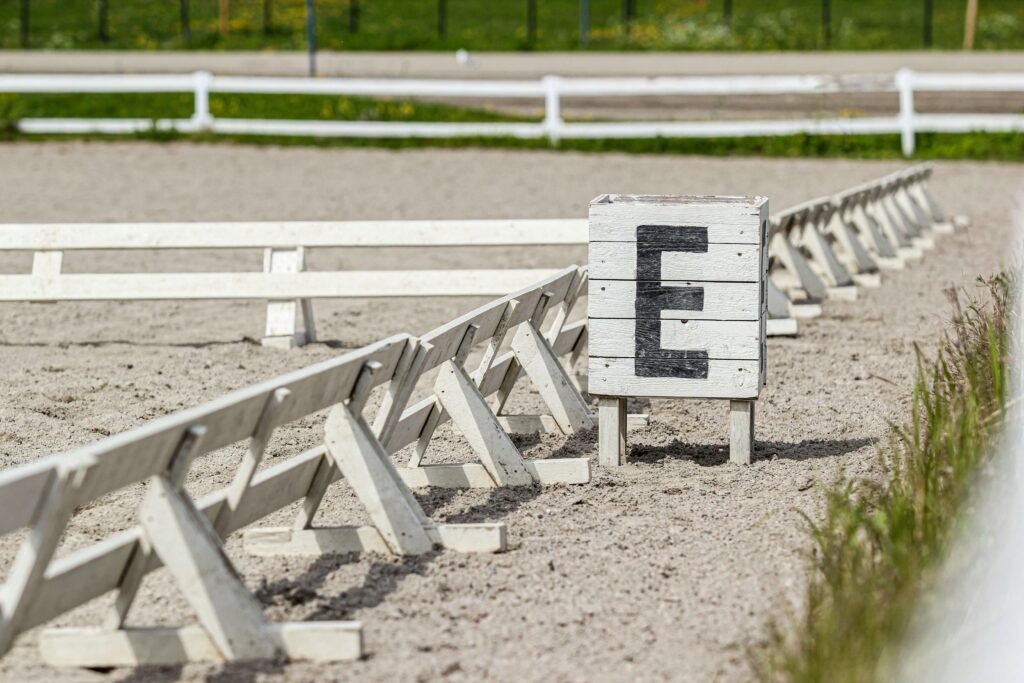
There are eight letters around the smaller 40 x 20 arena, and these will usually be clearly signposted. There are a further three inside the arena, though these are not usually marked and are less likely to be referred to. The letters are always laid out in the following way:

Most riders will usually internalise the letters after a few lessons or a few hours of riding in an arena, and will become familiar with their positioning.
The standard 60 x 20 arena has four additional markers on the outside to help with the extra length, and one additional marker on the inside:

Origin of the Letters
There is some debate on where these letters came from, but a popular and likely story is that they originated at the Imperial Court in Berlin in Germany during the nineteenth century. The stables at the royal court had letter markings on the walls of the stable yard to designate where each horse was to stand ready for their rider. There was also was an A marker for the exit (ausgang in German) but the C has no corresponding rider or other explanation:

These markers were then copied by the German cavalry, where the stables were often arranged around a 60 x 20 metre space used as an exercise yard, and from there they were copied and spread to other places.
Whether or not the exact letters as we know them today originated in this way, there is good evidence that various letter markings were used by the German cavalry. Manuals of the cavalry from 1882 have a diagram of an arena marked with letters, though they are not the same layout as used today.
Letter markers were officially introduced at the 1932 Olympic Games in Los Angeles, where a 60 x 20 metre arena was used, after which they seem to have become a part of the dressage tradition.
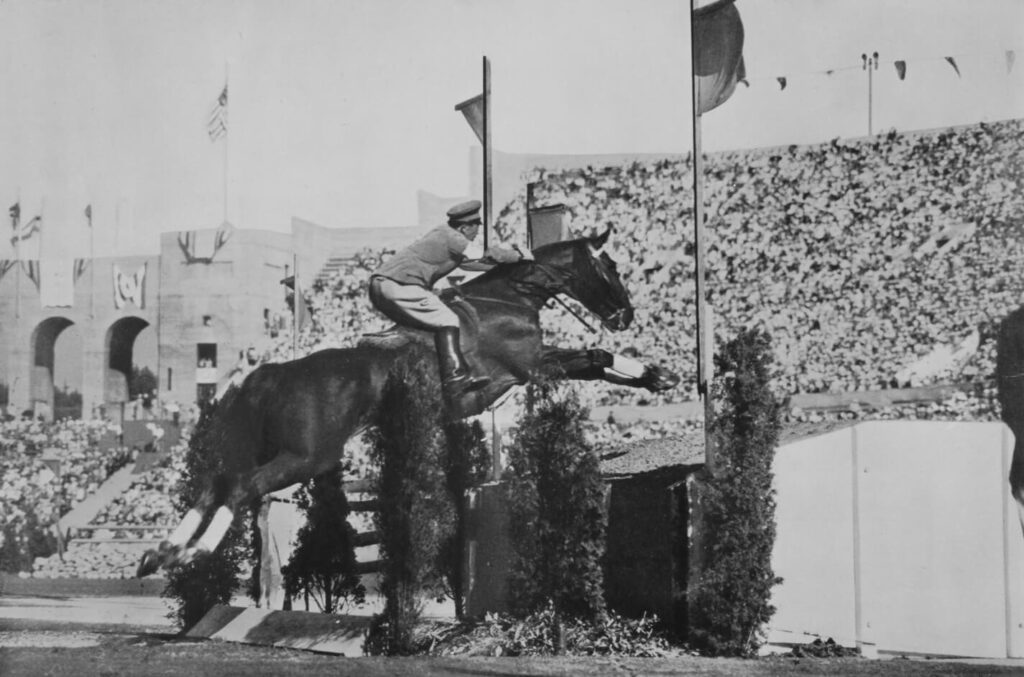
Interestingly, there is another theory for the origin of these particular letters. It is thought that perhaps an Olympic official simply made them up to help with the dressage test movements. If true, then the official’s inspiration would likely have come from the many arenas already having various letter markings.
Whether or not this latter story is true, I don’t find the idea of a olympic official deciding to assign random letters as appealing as the letters originating in the Imperial German Court, but you can make your own mind up on which is the more plausible origin.
Floor Types
Arenas can have different types of flooring for the ground. This is known as footing, and is usually 5 to 15 cm (2-6 inches) thick, depending on the material used and the purpose of the arena. The following are some of the possible materials used for footing:
Sand: this is perhaps the most popular choice. It is often mixed with other materials to overcome some of the negatives described below.
- Advantages:
- easily available in most locations
- relatively cost-effective
- drains quickly
- Disadvantages:
- requires more frequent watering during warmer periods
- can grind down over time depending on the type of sand used
Wood: usually wood chips but can also be sawdust.
- Advantages:
- cheap
- provides decent cushioning
- keeps moisture better than sand
- Disadvantages:
- is organic and will naturally degrade
- needs regular topping up
- can work out to be less cost effective over time
Stone dust: this is crushed rock, usually granite, and is sometimes called manufactured sand.
- Advantages:
- one of the cheapest materials to use
- drains well
- provides good stability
- Disadvantages:
- very dusty
- requires frequent watering
Fibre: this is shredded textile fibres, including carpet, and is often mixed with felt.
- Advantages:
- provides good cushioning
- retains water well
- Disadvantages:
- often has toxic elements which can seep into the water system and pollute the local watershed
- difficult to dispose of at the end of its life
Rubber: usually rubber chippings. It is often mixed with other materials to reduce the cushioning, which is too much when used on its own.
- Advantages:
- good cushioning
- lasts long
- doesn’t grind down like sand
- doesn’t create dust
- Disadvantages:
- may contain toxic chemicals
- does not retain moisture well
- difficult to dispose of
Waxed Sand – this is an excellent surface that has all the advantages of regular sand, with the wax mitigating the disadvantages.
- Advantages:
- long lasting
- requires minimal maintenance
- is durable against heavy usage
- less dust and kick back than regular sand
- require less watering
- Disadvantages:
- expensive
- higher frictional resistance that stops the natural forward sliding movement of the hoof more abruptly than sand or dirt
Some of the materials like fibre and rubber are more likely to be mixed with sand as additives to create a composite footing that combines the benefits of both, and reduces some of the negative aspects of sand.
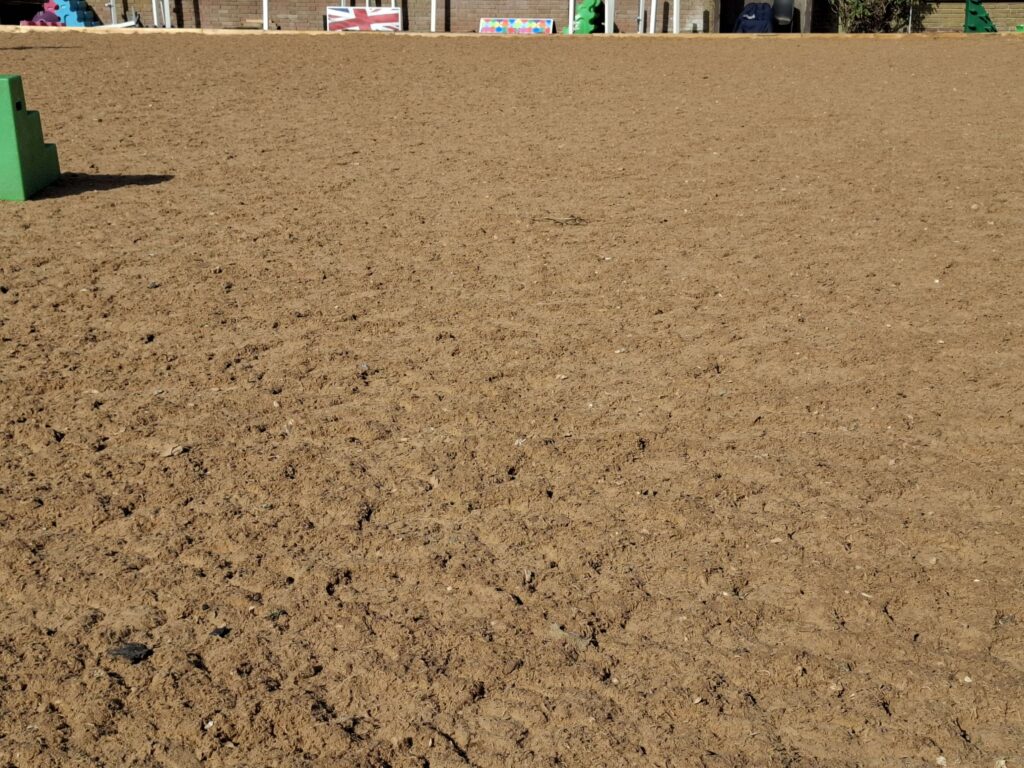
Fence Types
A fence or some type of boundary is required to demarcate the arena. This could be a low rail a few inches above the ground, sometimes known as a pipe dressage arena.
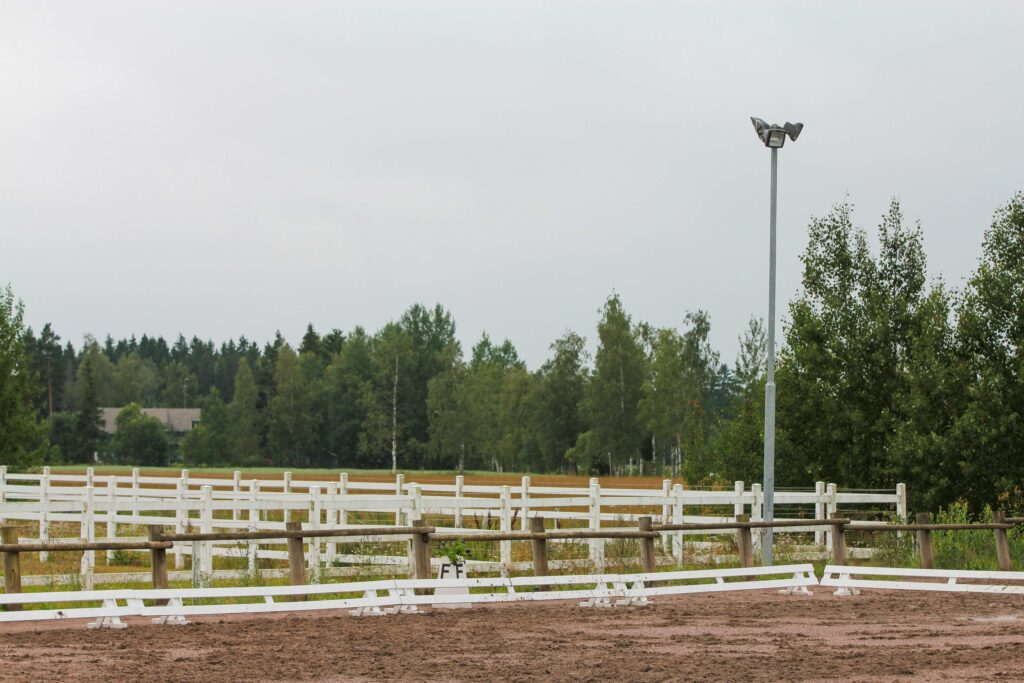
Or the more commonly found post and rail. Some private arenas decide to just have a small hedgerow around the boundary.
Advantages of Riding Outside the Arena
While there are many advantages of riding and training inside an arena, it is worth mentioning some of the advantages of riding outside the arena.
The primary benefit is that it is good practice and conditioning for both rider and horse to experience the varying terrain and environment that outside riding provides. There are, of course, a lot more distractions and potentially scary things for a horse to get spooked by, but whether riding on a trail, though the countryside, or on roads, it is good to build up this type of experience.
Riding together in the real outside environment helps build trust, while riding without a fence line to keep the horse in check lets the rider know how much control they actually have, and whether the horse is responding to their aids in a timely fashion.
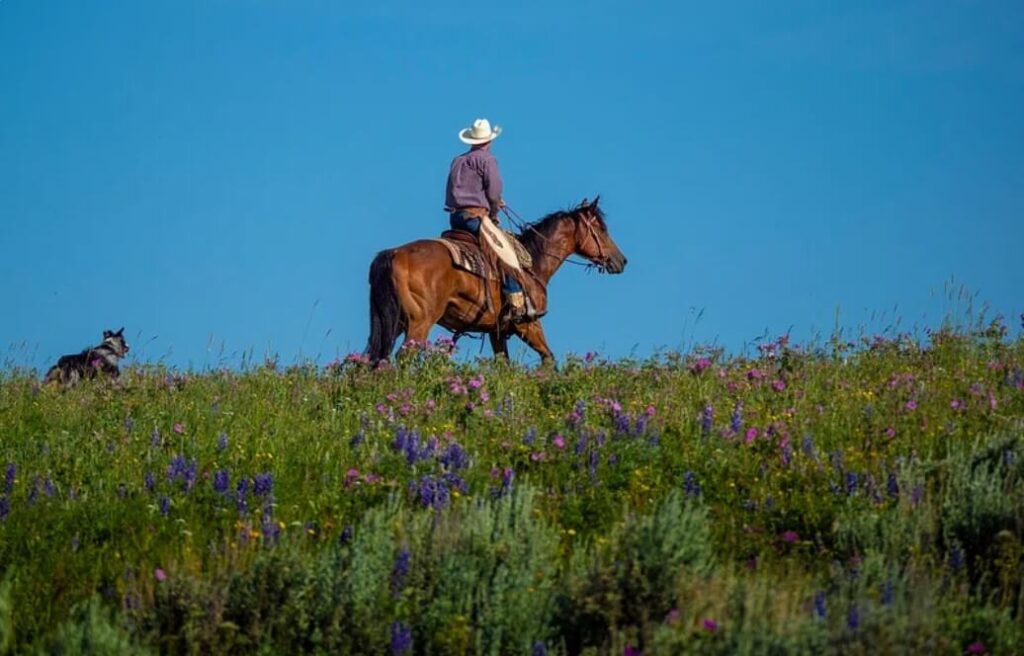
The horse will likely have to deal with going up and down hills, unlike in a flat arena, and this effectively acts as a form of strength training. It also helps avoid strain injuries. In the arena the horse is working in the same constrained space with similar movements, and this stresses the same parts of the horse’s body causing wear and tear injuries. The varied and open terrain outside is a more natural environment.
Finally there is really nothing like the absolute freedom and exhilaration you feel when riding outside, especially in the open countryside. This is without doubt the greatest advantage of all.
